#bekkou
Explore tagged Tumblr posts
Text
Recommending Manga Day 5:
“Koe no Chiisai Komori-san to Kusodeka Oogoe no Oobayashi-kun / Komori-san in a Small Voice & Obayashi-kun in a Loud Voice” by Bekkou Riko
Summary: “Komori is complexed about her soft and quiet voice, which is the complete opposite of Oobayashi, who always speaks in a loud and rowdy voice. But although their volume contrast each other, their feelings are mutual. Will they ever be able to communicate to each other?
(Source: Kadokawa, translated)”


My opinion: I also read this manga a while ago, but I remember screaming of wholesomeness! It’s a 9/10 for me, because I also got a little bit of second hand embarrassment from Obayashi, the Male Lead… lol. But overall I loved it and the art style is amazing!!
MAL link:
#manga recommendation#manga romance#romance manga#10/10 reccomend#book reccomendation#manga review#romance#manga books#reading reccomendations#review
2 notes
·
View notes
Text
After doing a bit more diving, it looks like Japanese has more names for specific color and pattern, not all of which translate directly. Even cat lovers can get confused. I was not properly appreciative of the distinctions, so let me try again, with the help of this website:
So the handsome cat in the photo I found would actually be a サビ猫 (sabi neko), a “rust cat”. The orange part has stripes of lighter and darker orange, but the black part does NOT have stripes. Because there is no gray, the black looks very strong.
In the original chart, you can see that they put this label on the cat in the third column, fourth row.
A cat with blotches of orange and black is a べっ甲猫 (bekkou neko), a “tortoiseshell cat”. The orange ought to seem predominant. This label doesn’t appear in the original chart.
The キジトラ猫 (kijitora neko) or “pheasant-colored cat” has stripes, and black and orange pigments, but they are mixed so that the cat looks brown overall.

The straw-colored cat, 麦わら猫 (mugiwara neko) is actually different from all of the above, and looks like this:

The cat has patches of orange or black pigment, but the stripes in the black areas make them look mostly gray, and the overall effect is like wheat straw. It is not as flashy looking.
From left to right: straw cat, rust cat, tortoiseshell cat.

they shoulve never let my autistic ass get an animal that comes in difterent colors
7K notes
·
View notes
Photo


簪 Kanzashi (Japanese hairpins) and いち止 Ichidome (hairstops), handy charts by Edo lover Nadeshico Rin following the kushi/combs and kôgai/hairsticks ones.
Technically, kôgai (hairsticks, rod-like/single prong) were pratical hair accessories meant to hold mage (chignon), where kanzashi (hairpins, with 2 prongs) were used as decorations only.
Historically, two prongs hairpins differentiated from kôgai to circle around sumptuary laws* banning certain types/material for kôgai. (*I remember reading that kôgai could be used as weapons which probably weighted in the authorities’ decision to ban some kôgai types ^^;)
Nowadays in the West, word “kanzashi” often refers to “tsumami kanzashi” ie hairpins with silk flowers. But many types existed, many of which are now mostly seen worn in “traditional”/formal settings (tea ceremony, wedding, or by Geisha/Maiko for example).
As for hairpins types, you can see here from right to left, top to bottom (pins are more or less sorted chronologically):
Right column:
松葉簪 - matsuba kanzashi (pine needle hairpin) - straight forward name for this pin which looks like a big pine needle, it was popular during Meiwa and An’ei eras
紋入り簪 - mon iri kanzashi (crest hairpin) - popular during Meiwa/An’ei eras, this pin had a small crest carved between tab and prongs parts. Women could wear their family crest, but also their favourite Kabuki actors one’s for ex for historical fangirling ;)
輪形銀簪 - wagata gin kanzashi (ring shaped silver hairpin) - a simple yet refined pin which appeared around Shôtoku/Kyôhô eras. Apparently one of the first hairpins having two prongs + tab design
持出し簪 - mochidashi kanzashi (stick out pattern hairpin) - once again a popular Meiwa/An’ei eras pin, with carved flowery motifs sticking out
平打簪 - hirauchi kanzashi (flat crest hairpin) - another well known metal pin (still seen nowadays though crest part is often smaller) which appeared around Bunka/Bunsei eras. It has a flat tab shaped as crest, which can be stamped, carved or cut out
琴柱簪 - kotoji kanzashi (koto bridge hairpin) - the typical “Edo era” hairpin, popular since Kan’en/Hôreki eras. The elegant name is pretty straight forward as it does look like an elongated koto bridge
Left column:
べつ甲花簪 - bekkô hana kanzashi (turtle shell flowers hairpin) - a striking style which appeared in Bunka era. It was first worn by (rich) young ladies for formal/celebratory events. It is now only worn by brides on their wedding day.
べつ甲足つなぎ簪 - bekkô ashitsunagi kanzashi (turtle shell linked prongs hairpin) - a sturdy pin thanks to its connected ends, it first appeared during Bunka/Bunsei eras.
大耳簪 - ômimi kanzashi (big ear hairpin) - also appeared during Bunka/Bunsei eras, the telling name comes from its large tab.Edo people used the top part of hairpins (the ‘ear’/tab) to clean wax from their ears (using them much like ear pick/ear spoons) so this could explain the name of this pin - too big to be actually used for this purposed.
玉簪 - tama kanzashi (beaded hairpin) - a pin which appeared in Bunsei era and remained steadily popular through the ages and well into nowadays. The bead was usually made from sango/coral, but many variations existed (like jade for ex, but also cheaper materials like died horn, glass, celluloid etc).
房飾り付花簪 - fusakazari tsukihana kanzashi (tasseled flower hairpin) - a big pin with cute fluttering ornament worn by young girls from late Edo to Meiji era.
銀製花簪 - ginsei hana kanzashi (silver flower hairpin) - gorgeous flowery hairpin made from costly silver, popular from late Edo to Meiji era. Rin doesn’t say anything about it, but I don’t think this could have been anything but a special ornament for formal wear ^^
びらびら簪 - birabira kanzashi (dangling hairpin) - a style well known by Maiko fans! Those fluttering metal pins were popular during late Edo and Meiji era, especially among “musume” (unmaried women, especially refering to fashionable city girls). The beads here are coral ones
Ichidome note - ichidome are small hairpins meant to hold (dome) into place the “tail” (ichi) part of some nihongami hairstyles:
笄タイプ - kôgai type also known 髷どめ wagedome (”chignon stop”) - those pins were used from late Edo to begining of Meiji. They were especially fashionable in Kyoto/Osaka, among girls who wore them with sakkô hairstyle (an hairdo now seen on maiko during their erikae)
ピンタイプ - pin type - if kôgai types were used in Kansai, if I understand Rin currectly, Edo (Tokyo) fashionistas prefered to wear only one part of the kôgai pinned into their hair - which then lead to those small pins designs
#japan#Nadeshico Rin#history#fashion history#chart#references#ressources#fashion#japanese traditional hairstyle#haistyle#hairpin#hair#kanzashi#ichidome#kougai#kôgai#kushi#bekko#bekkou#turtleshell#tortoiseshell#edo#edo period#edo era#maiko#geisha#oiran#tayuu#tayu
1K notes
·
View notes
Text
today's megane is: Bekkou from Zombie Loan

12 notes
·
View notes
Photo









Odds and ends from Zombie-Loan 👓
#Zombie Loan#Zombie-Loan#Zarame#Shiba Reiichirou#Bekkou#Yuuta (Zombie-Loan)#Yoimachi Koyomi#Kuze Shimotsuki#Raika (Zombie-Loan)#odds and ends#iconnot icons#source: anime#source: ops/eds
4 notes
·
View notes
Photo

Bekkou the Eastern Box Turtle via /r/turtle By:Compybug - https://ift.tt/30uNA9P
5 notes
·
View notes
Photo

昨日の収穫(^。^) タイのツボ押しと べっ甲の猫ストラップ #acupuncture_point #massage #acupunture #acupuntura #bekkou #japan #traditional_crafts
0 notes
Text
Tenka Hana NPC voting/election
Voltage is saying that there’s 65 people in total, I don’t know if I have the patience to post EVERYONE. So.... I probably would just do random selections of people...

「Saizo-san! Saizo-sanSaizo-san! 」
Fuuma Kotaro
The Hojo ninja who loves Saizo. He likes broken objects.

「Let the Sanada way of life be burned into your eyes」
Sanada Masayuki
The head of the Sanada clan, Nobuyuki and Yukimura’s father. Though he appears strict, he is a devoted husband
{”devoted husband”... my heart is hurting already :’D}

「Oyakata-sama! Please entrust this to me」
Shibata Katsuie
Nobunaga’s vassal. He often takes care of Toshiie. His hobby is Kanpu masatsu (scrubbing your body with a dry towel)

「Do you not understand even this...?」
Maeda Toshihisa
Toshiie’s older brother. He has a weak body and often coughs up blood. Though a difficult man, he cares for his younger brother.

「How long are you going to make me wait for my bekkou-ame?」
Takenaka Hanbei
Hideyoshi’s adviser. His favourite phrase is “*sigh* This is the worst”. He seems to be suffering from a pulmonary disease.

「Something like falling in love... I... I...」
Uesugi Kagekatsu
Kenshin’s nephew. He doesn’t speak much, but he’s honest and sincere. His only fault is that he falls in love too easily.

「 If you’re going to battle, do it after filling your stomach」
Bessho Nagaharu
Nobunaga’s vassal. He cannot acknowledge Hideyoshi’s success, and gets irritated over it.

「Get out of my sight」
Sakakibara Yasumasa
One of the Tokugawa Four Guardian Kings. He greatly esteemed the cold-blooded Ieyasu. He has a foul mouth.

「Thank you for always looking after Kojuro」
Katakura Shigetsugu
Kojuro’s older brother. As a Shinto priest, he has a warm personality. He’s always looking out for Kojuro.

「Ichimatsu can’t do anything without me」
Katou Kiyomasa
A childhood friend of Hideyoshi’s. He’s mischievous and cheerful, but he turns cruel towards enemies.

「Will you eat my miso soup everyday?」
Fukushima Masanori
A childhood friend of Hideyoshi’s. Though he looks scary and aggressive, he’s actually very good at housework carefully.

「Hey Ujiyasu, what in the world are you thinking of...」
Hojo Ujitsuna
The head of the Hojo clan. Cold-blooded and ruthless. He seems to be troubled because he cannot communicate well with his son.

「Old men are no-go, huh? ... Naw, just kidding.」
Katakura Kagechika
Kojuro’s uncle. He was quite the prankster in his youth, and often got yelled at by Ibano.

「I pray for Young Lord and my lady’s happiness.」
Ibano HIromasa
A senior retainer at Oomori Castle who has been taking care of Shigezane. He greatly loves ikebana.
*) I translated “Hime” as “my lady” because saying “princess” makes the sentence sound awkward

「I was able to face Mitsunari with resolve because of your words」
Ootani Yoshitsugu
Hideyoshi’s vassal and Mitsunari’s comrade-in-arms. One day, he suddenly disappeared...

「... Rice-crackers-person」
Kuroda Kanbei
Hideyoshi’s strategist. A man always hungry for knowledge, he would talk endlessly about the subjects he is passionate about.

「It’s yours truly, Kennyo~」
Kennyo
A monk from Honganji who interacts closely with Nobunaga. His dubious factor is certified.
*) ... 因縁深い is something like “having deep connection/strong relationship to each other” but I don’t want to make it sound like he and Nobu are good friends because they’re... obviously not... I mean “strongly horrible” relationship is still “strong relationship”, I guess... but... AUGH

「Perfect. I will praise you for choosing me.」
Imagawa Yoshimoto
The head of the Imagawa clan. He was the man who once held the title of “Greatest Lord of Kaidou”
*) As I may have mentioned before “The Archer of Toukai” really means “the greatest lord of Toukai/Kaidou”. It doesn’t mean the person with the title is literally good at archery.

「Yo! Come play with me?」
Oniniwa Tsunamoto
Masamune’s vassal. Though adventurous, he serves wholeheartedly. He has travelled across Japan, and even to Western lands.

「What I wish for is a future for my wife and Oshu...」
Date Terumune
Masamune’s father and the head of the Date clan. He wants to make Masamune a great leader of the Date.

「I work for my lord. That’s all there is to it.」
Nedzu Jinpachi
Sanada’s guardian. Though he is rarely seen, with a single command from Nobuyuki he would immediately appear.

「I have no interest in you. Everything is for Saizo’s sake.」
Momochi Sandayuu
The chief of Momochi Village of Iga. He desires for Saizo to succeed him.
{Sorta wish that there is actually another Momochi TBH. What with word being said that Momochi Yasumitsu and Momochi Sandayuu are grandfather and grandson, not the same dude}
--------------------------
This is not exhaustive list. If you need any other character not listed, send me an ask and I’ll post it.
All posts relevant to the NPC election can be searched through the “Tenka NPC Election” tag.
204 notes
·
View notes
Photo

23 เมษายน 2562: ไมโกะ Kimishou (โอกิยะ Honjo) จากเขต Miyagawacho ในจังหวัด Kyoto
ในวันพิธีแสดงตัวครั้งแรก (店出し : Misedashi) ไมโกะคนนั้นจะสวมชุดที่เป็นทางการที่สุด คือ กิโมโนสีดำ (黒紋付 : Kuromontsuki) โอบิสีทอง ซับในกิโมโนแดงลายทอง (長襦袢 : Nagajuban) สวมปิ่นปักผมรูปพัดคู่ (びらびら簪 : Bira Bira Kanzashi) 2 ชิ้น และเครื่องประดับผมสีเหลืองทองที่ทำจากกระแท้ (べっ甲調かんざし : Bekkou Chou Kanzashi)
Source: mayomayo41212 on Twitter
9 notes
·
View notes
Photo

Sharing my journey into tasting the things that KoiRan/SLBP kept showing in the game: I bought Bekkou Ame (Hideyoshi's favorite) and Kompeito (Nobunaga'a favorite) recently.
16 notes
·
View notes
Video
Maiko Kikune is now wearing Sakkou! by Geiko Kikumaru Via Flickr: Amazing news coming from Hanafusa okiya - Maiko Kikune was spotted wearing formal attire and with her hair styled into Sakkou hairstyle. This means that in about a month Hanafusa okiya will have new Geiko. Kikune san's erikae celebrations will take place in beginning of winter and we encourage You to come and witness this extremely rare event in the life of the Second Life Karyukai Now lets have a look at the outfit that Kikune san will wear during her "sakkou" stage: Hair: during this last month as a maiko, a very special Sakkou (also known as saki kogai) hairstyle is worn and that is why this stage if often referred to as "sakkou". Before it was adopted by Karyukai, it was worn by the brides-to-be during the Edo era and it signified a dedication for a future husband. Nowadays, by wearing sakkou geiko-to-be shows her dedication for the profession and willingness to continue as part of the Karyukai. As you can see, from the front it does remind a normal Maiko hairstyle(such as ofuku or wareshinobu) but if you look at the back you will notice how extravagant this hairstyle really is - elegant and smooth lines of hair, decorated with silver wires and red bands. Truly, a masterpiece! Kanzashi: specially ordered custom made daikan kanzashi crowns the hair of Maiko Kikune - it features crane flying upon a pine and a bekou fan that has Hanafusa mon (crest). all of these elements are considered lucky and are to bring good fortune. 2 bekkou hairpins and kushi were gifted to her by her oneesan Geiko Kikutsuru Make up: Formal make up with three lines at the back is worn and you can notice that there is more black and almost none pink, meaning she is now a mature lady Eri(collar): with formal sakkou looks also comes special eri that has red background with beautiful golden embroidery(small golden dots) Kimono and obi: as Sakkou stage is considered a highly formal occasion, Kikune san will be wearing most ceremonial, custom made black kuromontsuki that has 5 Hanafusa crests on it. This masterpiece features peonies. Peony (Botan) is known as the 'King of the Flowers' and symbolizes good fortune (wealth), high honour (nobility) and ageless beauty. It is tied golden obi that has noble cart motif
1 note
·
View note
Link
0 notes
Text
Toyotomi Hideyoshi Artbook Info Translation

Toyotomi Hideyoshi: The Miracle of Sengoku
Warm and kind, he’s capable of blending seamlessly into any social situation. But sometimes, he looks sad… What is he hiding behind his kindness?
PROFILE Personality: Playful, mood maker Birthday: 17th March Height: 175cm Weight: 68kg Skill: Negotiation Favorite food: Bekkou-ame Dream: To live in peace and serve a talented lord
SECRET INFO He’s super popular with women wherever he goes, but even though he’s not that short, he has a complex about his relatively smaller build. When he and MC were playing with sparklers, he hugged her from behind and confessed that he had been inflating his height all along and pretending that he was 179cm tall.
ILLUSTRATOR COMMENT A character who was redesigned from scratch. It probably doesn’t need to be said, but the base for his image was a monkey. He was required to have big ears, and I completed his design with short hair and a kind face.
@shigetsugu @koudaiin
[previous translations: Kageie, Shigezane]
UPDATE: there is this weird thing that’s happening when people reblog these posts - sometimes it cuts off after the first paragraph, so the profile/secret info/illustrator comment doesn’t show up. i have no idea why :(
#slbp#samurai love ballad party#tenka touitsu koi no ran#slbp hideyoshi#slbp artbook#sometimes i translate stuff#does 4cm even make a difference#ok the confession is funny i guess LMAO
171 notes
·
View notes
Photo
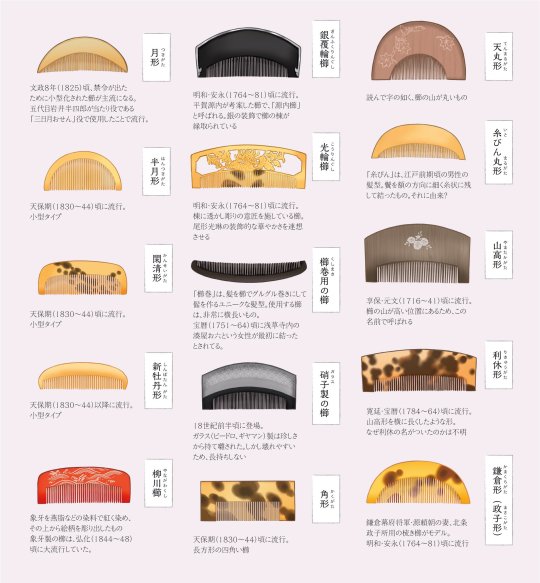
櫛 - kushi (Japanese combs types), handy chart by Edo lover Nadeshico Rin.
Rin doesn’t detail materials, but you can see here illustrated tsuge/boxwood (+dark woods I can’t replace for yamataka, maybe sugi/cryptomeria for tenmaru?), bekkô/turtle shell, zôge/ivory, shikki/lacquered wood, glass.
While translating this chart, I stumbled upon this overview of the Kushikanzashi museum dedicated to hair accessories. It reminds that before Edo era, women used to wear their hair down/loosely tied (垂髪 subeshigami styles = hair tied behind and hanging down/long flowing hair).
When nihongami appeared (=the trademark Japanese bun we think of when thinking about “ancient Japan”), it was first considered casual style, so a woman would in fact nor wear an updo for formal events.
When nighongami spread, demand for combs increased, leading to a flourishing craft.
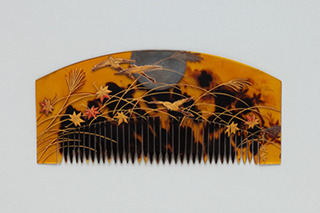
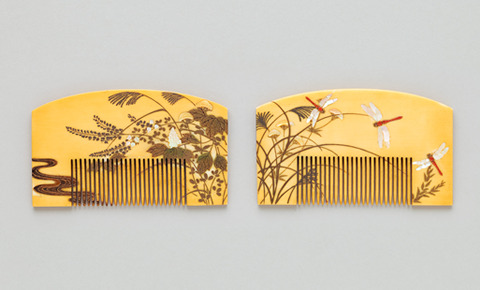
Combs also varied widely during the whole period, following the fashion and styles, from big+wide during peak Edo (which loved big hairstyles) to dainty+narrow in Meiji era (where hairstyles were much more muted).
As for the combs types depicted by Rin, you can see from left to right, top to bottom:
First column:
月形 Tsuki gata (crescent shaped) - small comb like this one became popular around 1825 after a sumptuary law banned more extravagant combs. This one was made famous by actor Iwai Hanshiro for the character Mikazuki Osen.
半月形 Hantsuki gata (half crescent shaped) - a small comb like tsuki gata, with a somehow thin and even spine and long teeth, popular during Tenpô era.
閑清形 Kansei gata (kansei shaped) - a small comb with a soft rectangular shape, popular in Tenpô era.
新牡丹形 Shinbatan gata (”young peony” shaped) - small comb with a small spine and rounded corners, fashionable after Tenpô era.
柳川櫛 Yanagawa kushi (Yanagawa comb) - a small comb made from ivory dyed red, then carved to revealed white patterns. Such combs were popular during Kôka era.
Second column:
銀覆輪櫛 Gin fukurin gushi (silver ornemental border comb) - comb with a silver framed ridge, popular during Meiwa and An’ei eras. It is said to have been invented by famous jack of all trades Hiraga Gennai (and hence also named Gennai comb 源内櫛)
光輪形 Kourin gata (Kôrin shaped) - an ornated comb with openwork designs popular during Meiwa and An’ei eras. The patterns were inspired by works of famous painter Ogata Kôrin hence the name
御巻用の櫛 Kushimakiyou no kushi (hair roll comb) - a long comb, big enough to wrap the entire hair around. In Hôreki era, A kyûji onna (teahouse waitress) named Minatoya Oroku who waited a teahouse in the precincts of Sensoji Temple is said to have invented this style who soon spread among the population.
硝子製の櫛 Garasusei no kushi (glass comb) - appeared in first half of 18th century. Glass was quite rare and precious then as it was a foreign good (as shown by the names used: ビードロ/bidoro from Portugese vidro or ギヤマン/giyaman from Dutch diamant). Such combs were very fragile.
角形 Kaku gata (angle shaped) - a comb with a straight rectangular shape, popular in Tenpô era.
Third column:
天丸形 Tenmaru gata ("all round” shaped) - a straight forward name for this comb which has a very large and round “yama“ (spine part) which leave plenty of room for decorations (painted, inlaid etc)
糸鬢丸形 Itobin marugata (itobin round shaped) - “Itobin” (lit. thread like sidelocks) was a men hairstyle from early Edo era (head mostly shaved except for thread like locks on temples and nape). OP wonders if the name of this comb originated from this peculiar look? It’s true the shaft kinda looks like a balding head with the tiniest bit of hair left ;)
山高形 Yamataka gata (tall mountain shaped) - a style fashionable during Kyôhô-Genbun eras. The name is pretty straight forward as it has a pretty high (=taka) spine (=yama”), which made a nice canvas for decorations.
利休形 Rikyuugata (Rikyuu shaped) - popular during Kan’en and Hôreki eras, this comb looks like a longer yamataka comb. OP doesn’t know why it was named after the Rikyû school of tea ceremony.
鎌倉形 Kamakura gata / 政子形 Masako gata (Kamakura shaped / Masako shaped) - a comb popular during Meiwa and An’ei eras, named after the “nun shogun” Hojo Masako (wife of Minamoto no Yoritomo, the first shogun of Kamakura shogunate). Such combs were not only ornmental but also used to untangled and straighten the hair - it the go to shape when one’s think about Japanese combs.
#japan#Nadeshico Rin#history#chart#ressources#references#fashion#japanese traditional hairstyle#hairstyle#fashion history#comb#hair#kushi#nihongami#boxwood#tsuge#bekko#bekkou#turtle shell#ivory#shikki#lacquered#lacque#edo#edo period#edo era
1K notes
·
View notes
Text
Basic Japanese Cuisine: Week 2
Week two started with a little review from week one. We repeated our nimono and mishimono day so we could try it again, and perhaps improve on the dishes from the Friday before. We learned more in depth about simmered and steamed dishes. For example, for nimono (simmered dishes) there are two main categories; one where everything is cooked in the same pot, like nikujaga, and takiawasei - where everything is cooked separately and brought together at the end. We learned that in a restaurant the nimono person has to be one of the most skilled workers. This is because each day they must check that the dashi is consistently perfect, as well as they must find the best possible produce each day, and they must account for the difference in quality and make the proper adjustments. Other variables that the nimono person may have to take into account may be the size or type of the pot and the type of heat source they are using. In mishumono, or steamed dishes, there is no flavored liquid such as dashi, to cook the ingredients; rather it is cooked with only steam. There are a lot of variables you must consider when making a steamed dish. Here, you cant remove any impurities in the middle of the process, you cannot season as you cook- no adding or removing flavors, and you should only use ingredients that can handle the steam- such as avoiding pungent fish and some vegetables. That day we remade chowmushi, but this time it included more chicken and shrimp, and was in a different shape bowl. We also made grilled eel (Unagi hasu mushi) which was steamed after it was grilled. To steam it, we made a combination of grated lotus root, mushroom and whipped to soft peak eggs. We coated the top of the eel in the bowl and it gave a mountain like appearance. With this was ‘bekkou an’ a thickened sauce made from flavored dashi. In addition we remade nikujaga which came out better this time because we did it much closer to eating, so this time it was extremely hot.
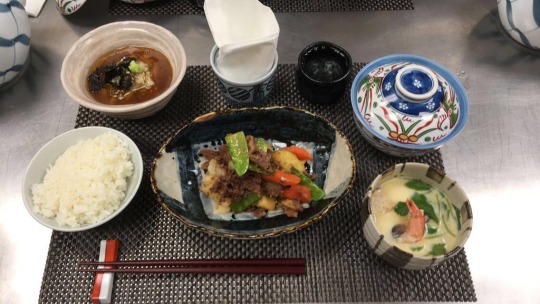
Day seven was a day where we real immersed ourselves in learning to make sashimi. We learned the ways to tell the best quality fish (such as eye color and clarity, how tight the scales hold to the body, the feel and firmness of the flesh, and the gill color- vibrant vs not), the types of fish that degrade the fastest, and the fact that some fish such as tuna need time for the muscles inside of them to relax so the mouth feel is better when eating.

Sensei showed us the fabrication of seabream, mackerel, porgy, and flounder.

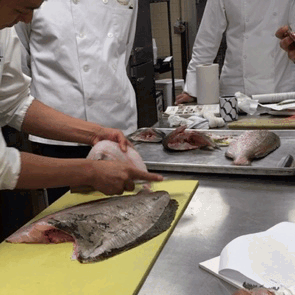
Sensei discussed to pair the whiter fleshed fish with a lighter ponzu sauce, while pairing fattier fish with a darker soy sauce. With all of our fish we cut the sashimi. This time we had some experience, so we were able to cut the fish in sashimi pieces much better. To accompany our sashimi, Chef Martin made us a tofu dish with a flavored dashi sauce, ginger, and scallion.
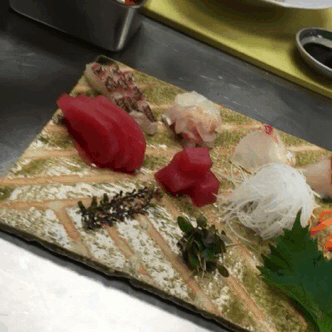
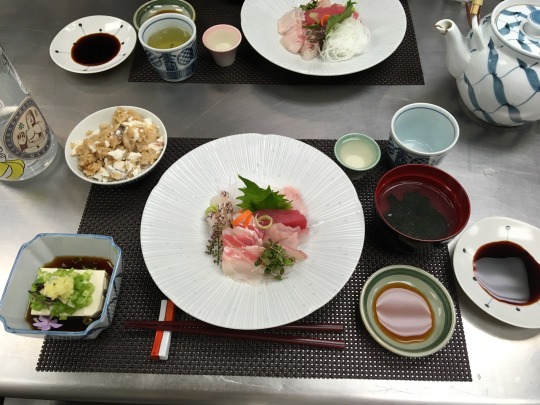
Day eight was yakimono aka grilled foods day. We used a grill box in order to cook our fish. We would skewer the fish so it was in a wave- like form, and we would cook it to get the beautiful dark grill marks, then add a glaze, and cook more to get the glaze locked on to the fish.
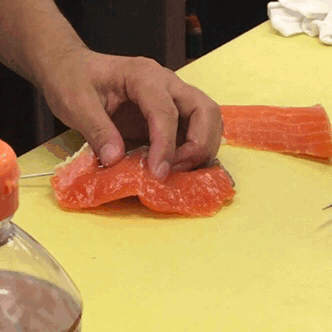
We made another dish with chicken and spinach that was coated in a tahini and tofu thick dressing. We also made a nanban tsuke dish with fried horse mackerel. The special thing about this dish was that we cooked the vegetables in a pan with a hard sear just to get the flavor that comes from the vegetable after that process while we didn’t fully cook the vegetable. The vegetable was put in a vinegared dashi along with the fried fish. It was curious to me that we put the fried fish in the sauce because it would lose the crispiness, but that was not the point- we wanted the flavors that would come with the frying process. The fish that night was excellent and extremely flavorful. I loved the flavor and crispness that came from the open grill. With the fish we plated leaves that beautifully represented fall.

Day nine was very similar to the day before because most of it was a repeat in the process wo we could better learn the techniques. In the lecture we learned more about yakimono and the different types of heat that one could use to cook yakimono. The direct heat methods include charcoal, gas, and electric, and all have their pros and cons. We also learned the main categories of grilled foods which include shioyaki (salt grilled), yuanyaki (marinated), teriyaki (glazed), misodengaku (miso topped/ based), and keshoyaki (layering and grilling with different sauces). We learned about salting fish and its importance. When fish orders come in it is typical to immediately break them down into their fillets so they can last longer. The extra step is to salt them for at least 30 minutes, rinse it off, and dry the fish before storing it. This process is done to improve flavor, to draw out moisture, firm the flesh, and to take out the fishy taste/ aromas. It was very fascinating to learn that most American chefs don’t even know to do this process, while it is critical in Japan. We repeated the nanban tsuke, the chicken and spinach salad, as well as our yakimono fishes. In addition we learned tamogoyaki which is the Japanese rolled omelet. Sensei showed us the proper heating and greasing of the pan. He flipped the eggs so perfectly that when he cut into it the all of the lines were even.
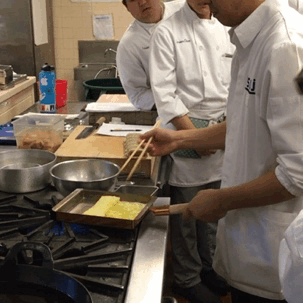
That accompanied our meal with everything else from yesterday’s meal. I was surprised that mine came out quite alright.
Day ten was Friday, aka tempura day. Today we made the tempura and plated it rather than frying it and eating it one at a time like we had in Tokyo. We did it this way because this day was more focused on learning the technique and the following Tuesday would be putting our skills to the test. We first learned to cut the ingredients. Shrimp specifically was different because we pealed the shrimps up to the tail, deveined, scored the belly side, then flipped it over and massaged the tendons on the side. This was all done so that when we fried the shrimp it didn’t want to go to its original form. In addition to shrimp we had anago, lotus root and, shiso leaves. We learned about the importance of the batter and how to make it right. This type of batter had a tendency to get over worked, so it was important to be constantly switching it out for new ones when we saw the quality decrease. It is important to make the batter with low gluten, so we used a mix of cake flour and tempura flour. When mixing together the batter it was important to use large chopsticks as a way to not over mix it. We also only mixed it halfway until homogenous. We were able to monitor the quality of the batter by the way it acted when it touched the hot oil. It the batter stayed in a little dumpling drop when a little was dropped in then we needed to switch it out, but if the batter frayed when it touched the oil, it was just right. We also learned how to monitor the proper oil temperature and maintain it. The optimal temperature range is 338 degrees F to 347 degrees F. The way we could tell the temperature was by dropping in some of the batter with the chop sticks. At 300 degrees the batter would stay on the bottom of the vessel for a few seconds, the batter would hit the bottom but just so quick it would pop up when the oil is at 320. At our optimal range, the batter would drop down only half way the depth of the vessel and come right back to the surface. At 355 degrees F or above, the batter would hit the surface and disperse. When dropping the ingredients into the batter and into the fryer we would use long wooden chopsticks, then to fish them out we would use long metal chopsticks; this was a way to keep them clean. In addition to the individual ingredients, we made kakiage which was many ingredients such as onion slices, cubed scallops, asparagus, and green beans- mixed with the batter and kept into a cake. This would go on top of rice with a flavored dashi sauce on top. The kakiage was my absolute favorite because it was so flavorful and it perfectly matched with the rice.

0 notes
Text
Endless Rain Record
Die Japaner Kouichi Okamoto und Kyouei Design haben eine Schallplatte entwickelt die auf einer Seite keine spiralförmige Rille hat sondern fünf Kreisrunde Rillen hat. Je nachdem wo man die Nadel auflegt spielt dann der endlose ‘Loop’ eines fallenden Regentropfens.
27.05.2019
Die andere Seite ist ‘herkömmliche’ bespielt und enthält einen zehnminütigen Track im Stil eines Sommerregens. Ein enorm stylischer Schuber rundet das Ganze ab. Kostet $50 und gibt es hier.
Muss schon sagen, dass ich neugierig geworden bin. Für die Idee der endlos ‘loopenden’ Rillen auf jeden Fall schon mal Probs.
A vinyl phonograph record created by Japanese artist Kouichi Okamoto (a.k.a. Bekkou). This atmospheric record has circular grooves on its “drop” side, allowing the raindrop sounds to loop endlessly. The “rain” side includes a 10-minute track, featuring soothing sounds of a Summer rainfall. Each side is labeled with its respective Japanese character.
Both abstract and natural, the wonderfully ethereal soundtrack of the Endless Rain Record will evolve as it gradually becomes worn and scratched.
(via swissmiss)
*** Belong to the cool Kids! It’s Easy: Follow this Blog on Social Media like Twitter, Snapchat or Instagram for more Content of from Zwentner.com & about my Life ***
from ZWENTNER.com http://bit.ly/30O9seo via IFTTT
0 notes
